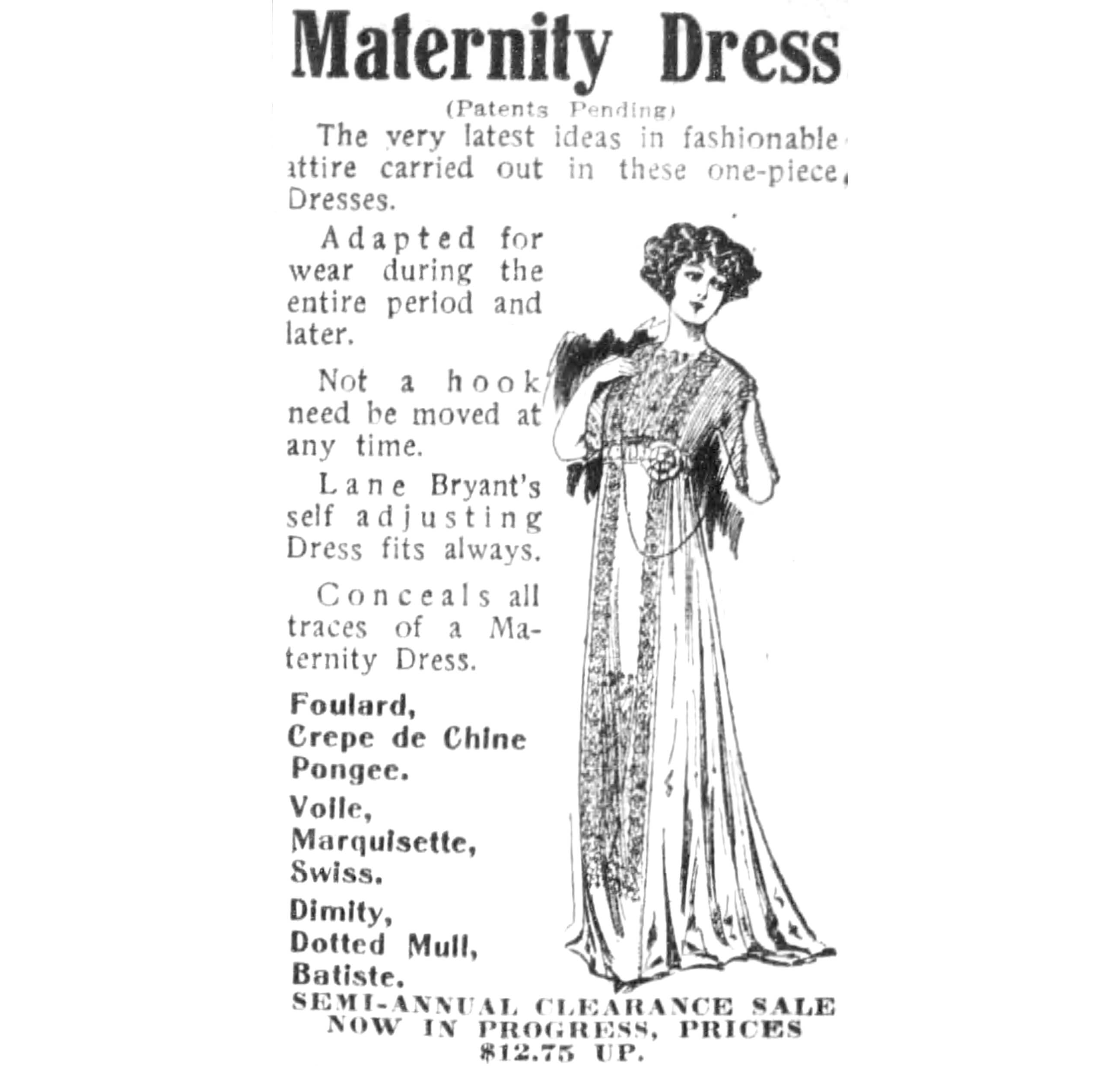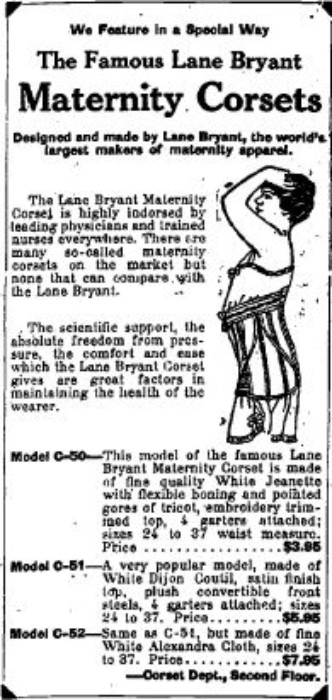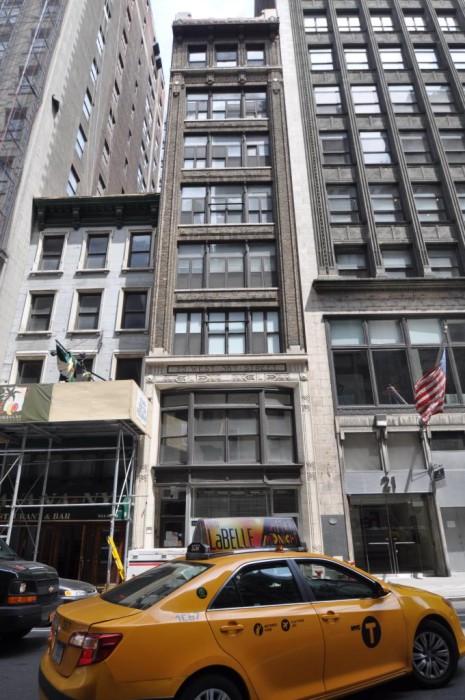Walkabout: Lane Bryant and the Riches of Expectation, Part 1
Lena Bryant had a gift for design and quality construction.

A 1922 announcement for the new Hanover Place store. Image via Brooklyn Daily Eagle
Read Part 2, Part 3, and Part 4 of this story.
Western society has long had a strange attitude towards pregnancy. Throughout much of its history, much has been made of producing children, whether they are the heirs to the throne, or workers on the family farm.
We’ve told women that it is a biblical duty to have children, but up until the end of the 20th century, many Western societies have been loath to see a woman walking around pregnant. As soon as a woman was showing, in polite society, she entered her “confinement” and rarely left home until after the baby was born.
It all has to do with attitudes about sex, and the war between fulfilling the biological and societal imperative to go forth and multiply, and the fact that one has to have sex in order to do it. We are a conflicted and messed up people.
At any rate, this is a story about a fashion empire and Brooklyn’s part in that empire. Pregnancy is at the heart of our story. At the turn of the 20th century, maternity clothes were not available the way they are now.

Women of means had their maternity clothing custom made. Those who could sew made their own, and everyone else made do by letting their clothing out, or wearing larger clothes. Or they didn’t leave home much.
But this was not the Middle Ages. Women were out and about, unescorted, in record numbers. Many middle and upper middle class women had jobs, many more were active in sports like bicycle riding, and most did not want to spend half their pregnancies locked behind closed doors.
There was a real need for well-fitting maternity clothing, including the ever present corset, so women could go out, be pregnant, and look beautiful and healthy. The conditions were right for the right person to come along and revolutionize the market. That woman was a Lithuanian Jewish immigrant named Lena Himmelstein.
She was born in Lithuania in 1879, and was orphaned when her mother died 10 days after her birth. She and her sister were raised by her grandparents. All of the men in her family had been rabbis, and young Lena was taught religious lessons and to read, write and do mathematics by her grandfather.
Her older sister immigrated to New York while Lena was growing up, and in 1897, at the age of 16, she too came to the United States, making the journey alone with a ship full of strangers.
Lena’s sister was married and a seamstress in a garment factory. Lena got a job at the same factory, making $1 a day. She learned how to use a more advanced sewing machine, and was making $4 a day when she met David Bryant. He was also Jewish, from Russia, and a bit older, with a worldly air about him.
The talented seamstress and the jeweler fell in love. Lena was soon such an expert dressmaker that she was now making $15 a day. They married within a year, in 1900, and ten months later, were parents of a son named Raphael.
A year later, David Bryant died, and Lena Bryant was a widow with a young son, and a desperate need to support them both.
David had given her a pair of diamond earrings as a wedding present. The earrings had already been in the pawnshop a couple of times, but always recovered. This time, Lena had to make the earrings pay for her family’s future.
She pawned them in order to buy a sewing machine. She and the baby moved in with her sister, in a crowded apartment on the Upper West Side. She began an at-home business doing piecework and making custom bridal and other lingerie.
Lena Bryant had a gift for design and quality construction. She worked hard, delivering her work personally, and turning part of her money back into fabrics and trims in order to make more. She was able to make a living.
In 1904, she opened a store on Fifth Avenue and 120th Street, across from Mt. Morris Park. She was finally able to move from her sister’s home, and she and her son lived in the back of the shop. She often spoke of how she sat Raphael on her lap while sewing. He would grow up to become president of her company.
Three years later, in 1907, Lena borrowed $300 from her brother-in–law in order to open a bank account and have some working capital.
She was awed and intimidated by the large bank and the importance of it all, so when the officer at the bank misspelled her first name, writing “Lane” instead of “Lena,” she was too embarrassed to correct him, and a store name was born. She would never be Lena, at least not in public, again.
The bridal lingerie business was doing well, as many of her brides became customers when they were pregnant as well. Lena did a brisk business in maternity lingerie and dressing gowns.
Most of her customers hardly ever left the house after a certain stage in their “condition,” but one day one of her former brides came into the shop, desperate for help. She was pregnant and wanted to host a dinner party.
She wanted Lena to design something that would hide her pregnancy. Lena came up with a dress with a pleated silk underskirt with an elastic waist. The pleats hid the baby bump perfectly.
The dress was a huge hit, and the word went out. Soon dozens of well-to-do women were clamoring for the same outfit and more. This dress was the first commercial maternity outfit. Ever.
Lena made more of these dresses, and they sold out as fast as she could make them. Lena, or rather Lane Bryant, had found her niche. She gave up every other kind of sewing and turned the focus of her business into designing and sewing for expectant mothers.
Of course, less wealthy women who had to work had worked while pregnant, but upper class women were still mostly confined by Victorian customs. Lena’s customers were thrilled to have attractive dresses that hid their pregnancies. One wrote in saying, “Oh, you don’t know what it means to me to have my husband’s business friends to dinner and not feel a freak.”
In 1909, Lena met and married Albert Malsin, an engineer by trade. He became her business partner, and financial wizard. Lena turned that side of the business over to him, and concentrated on designing. By 1911, the Lane Bryant shop was grossing over $50,000 a year.
Over the next four years, the couple had three more children, and were doing so well, they were able to move to the suburbs. Lena modeled the latest maternity designs with every new child.
The Lane Bryant Shop wanted to advertise in the newspapers, but in 1910, it was taboo to advertise maternity anything. It was uncouth to discuss such topics in the newspapers. It took Albert Malsin a year to convince the New York Herald to accept an ad.
When they finally printed the ad, the store’s entire stock sold out the next day. Since most papers still would not run their ads, the Malsin’s decided to print a Lane Bryant mail-order maternity catalogue. By 1917, the catalogue accounted for over a million dollars in sales. Good thing they had decided to invest in a new building.
In 1912, Lane Bryant moved into its new headquarters. It was a new building on the edge of Manhattan’s garment district, at 25 West 38th Street, just off Fifth Avenue. The building was nine stories tall, and had showrooms and retail sales on the two lower floors, and manufacturing and offices above.
The store design featured large dressing rooms where customers could see their clothing in privacy, and have cutom fittings. There was even an “evening room,” which was set up as a dimly lit ballroom or theater space where customers could see their evening gowns in the same kind of light they would be viewed in. It was a big hit.
The company operated out of this building for many of its most formative years. The building is still there, a classic garment center loft building. It is now dwarfed by much taller buildings around it. Lena began introducing all kinds of lines, including corsets and lingerie, day and evening wear, coats, separates and day dresses, all for maternity customers.
While doing maternity research, Lena also discovered another untapped market – larger sized ladies. Like pregnant women, larger, or “stout” women had to depend on made to order clothing. Lena was going to take her talents into this underserved and potentially lucrative market.
This move would soon surpass the maternity business and take Lane Bryant into every major city in the United States. And that includes a brand new store in Brooklyn. The story of Lane Bryant continues next time.
(Above: 1911 ad for one of the first mass produced maternity gowns. Brooklyn Eagle)







Fascinating. Great topic.